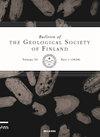Implications on crustal structure from the South Finland Coastal (SOFIC) deep seismic sounding profile
IF 1.3
4区 地球科学
Q2 GEOLOGY
引用次数: 1
Abstract
We present results from a deep seismic sounding (DSS) experiment carried out along the southern coast of Finland in summer 2015. Data used in the survey derived from industrial blasts recorded by temporary project stations and permanent network stations. The western 220 km part of the 450 km long Southern Finland Coastal (SOFIC) profile runs along the Uusimaa belt (UB) in the 1.7–1.9 Ga Southern Finland subprovince (SFS) of the Svecofennian domain, while the 170 km part in the east crosses the 1.62–1.65 Ga Wiborg rapakivi batholith (WRB). The farthest 60 km cross a geologically diverse area consisting of supracrustal rocks and granitoids of the Saimaa area (SA), an eastern extension of the SFS. Our results show that the Moho boundary depth varies significantly, from ca. 52–54 km below UB to 40–45 km below WRB. All three crustal layers (upper, middle, and lower) have their maximum depth in the contact zone between UB and the WRB. Below WRB, a lower crust with Vp ~6.7–6.9 km/s is observed. High velocity lower crust was observed below UB (Vp ~7.2 km/s) and possibly below SA (Vp ~7.35 km/s). The modelling was based on ray tracing, using the extrapolation of seismic wave arrival times with the help of travel times predicted from a one-dimensional velocity model. The resulting two-dimensional velocity model partly relies on data from the intersecting DSS profiles and supports previous observations of the lithospheric structure of southeastern Fennoscandia.南芬兰海岸(SOFIC)深层地震测深剖面对地壳结构的影响
我们介绍了2015年夏天在芬兰南部海岸进行的深地震测深(DSS)实验的结果。调查中使用的数据来源于临时项目站和永久网络站记录的工业爆炸。450公里长的芬兰南部海岸(SOFIC)剖面的西部220公里部分沿Svecofennian域1.7–1.9 Ga芬兰南部子省(SFS)的Uusimaa带(UB)延伸,而东部170公里部分穿过1.62–1.65 Ga Wiborg rapakivi岩基(WRB)。最远的60 km穿过由Saimaa地区(SA)的表壳岩石和花岗岩组成的地质多样性区域,该地区是SFS的东部延伸。我们的结果表明,莫霍边界深度变化很大,从UB下方52–54公里到WRB下方40–45公里不等。所有三个地壳层(上部、中部和下部)在UB和WRB之间的接触带中具有最大深度。在WRB下方,观测到Vp~6.7–6.9 km/s的下地壳。在UB以下(Vp~7.2km/s)和SA以下(Vp ~7.35km/s)观测到高速下地壳。建模基于射线追踪,利用一维速度模型预测的传播时间对地震波到达时间进行外推。由此产生的二维速度模型部分依赖于相交DSS剖面的数据,并支持先前对芬诺斯坎迪亚东南部岩石圈结构的观测。
本文章由计算机程序翻译,如有差异,请以英文原文为准。
求助全文
约1分钟内获得全文
求助全文
来源期刊
CiteScore
1.30
自引率
0.00%
发文量
5
审稿时长
>12 weeks
期刊介绍:
Bulletin of the Geological Society of Finland (BGSF) publishes research articles and short communications in all branches of geosciences. Contributions from outside Finland are welcome, provided that they contain material relevant to Finnish geology or are of general interest.

 求助内容:
求助内容: 应助结果提醒方式:
应助结果提醒方式:


